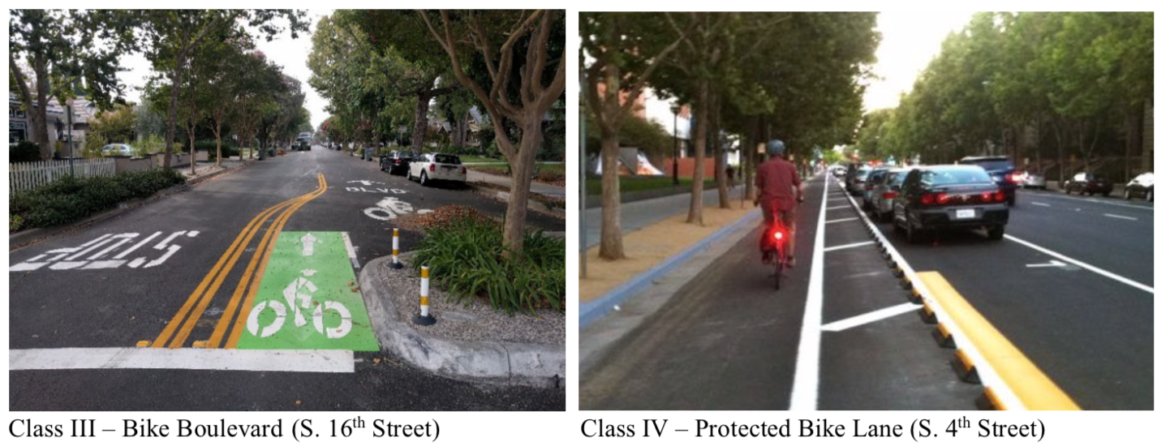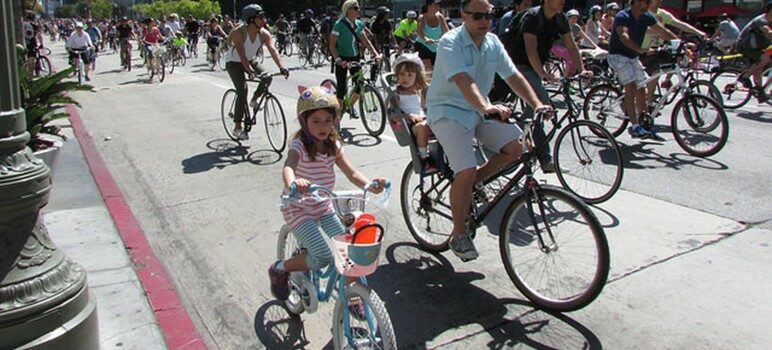San Jose transportation officials are gearing up for the latest iteration of the city’s bike plan with a renewed focus on safety and getting more cyclists on the road.
The Better Bike Plan 2025 is San Jose’s second blueprint for a citywide bike network. Its predecessor, the Bike Plan 2020, led to an additional 392 miles of on-street bikeways and 62 miles of trails since its adoption in 2009.
The new and ambitious plan, however, aims to build on the foundation set by the previous iteration by building 37 miles of new trails, 79 miles of new separated bike lanes, 101 miles of bike boulevards on slow-speed streets and the upgrade of 293 miles of existing bike lanes with new safety measures.
John Brazil, San Jose’s bike and pedestrian program manager, said the city intends to use quick build strategies, such as plastic bollards or painted lanes.
“These quick build strategies cut costs in half and take half the time to plan, design and build,” Brazil said at a Transportation and Environment Committee meeting earlier this week. “In the future, as additional funding becomes available, quick build facilities may be enhanced to add additional features.”
Transportation officials expect that building out the more than 500 miles of bike lanes and paths could cost anywhere from $250 million to $420 million.

The new plan calls for 101 miles of bike boulevards and 79 miles of new separated bike lanes. (Photo via city of San Jose)
But even with the new safety measures, the city still has an uphill battle when it comes to getting people to actually ride their bikes around town.
According to an analysis conducted by the Toole Design Group—a contractor hired by the city to develop the plan—58 percent of all trips in San Jose are within biking distance (three miles or less), yet only 1.8 percent of those trips are actually made on a bike.
A poll conducted by EMC Research showed that 48 percent of respondents said they were interested in biking more, but were concerned about safety.
John Cordes, an advocate with the Silicon Valley Bike Coalition, said the most difficult part of implementing the plan will be the culture change that comes with it. San Jose’s Envision 2040 general plan calls for 15 percent of all trips to be made by bike.
“The people who are out on the roads today are out on the roads today,” Cordes said. “It’s not the people who are riding today, it’s the people who we want riding in the future that we need to convince it's safe to ride. That's what the protected bike lanes are all about.”
Besides additional safety features, Cordes said the city will need to conduct a robust public education campaign, which he said is by far the weakest part of the plan.
“It doesn’t say how much they’re going to spend on education or encouragement,” he said. “It’s just a whole society change.”
In addition to improving safety and incentivizing more people to bike, the Better Bike Plan 2025 also places an emphasis on equity.
For decades, some of San Jose’s poorest neighborhoods have been underfunded when it comes to traffic safety, making the East Side and downtown home to some of the deadliest intersections in the entire city.
Between 2014 and 2018, District 7—which encompasses the Tully-Santee and Seven Trees neighborhoods—saw the most traffic fatalities with 52 deaths.
D3, which spans downtown, had the second-highest number with 34 death. It also saw the most collisions, with 5,544 during that same four-year timeframe.
“Past transportation decisions have prioritized more exclusive, expensive forms of transportation, built highways through low-income neighborhoods and disproportionately paved, rebuilt and upgraded streets in more affluent neighborhoods,” the plan said. “Recognizing this, the Better Bike Plan incorporates inclusive planning practices and provides a project list aimed at prioritizing investments in communities that have historically experienced a lack of investment.”
The Better Bike Plan 2025 comes up for City Council review on Sept. 29.


Speaking as a progressive, as long as privileged white people are killed, maimed, or otherwise inconvenienced at an equitable rate to people of color and the rest of the underserved community, then I’m all for it!
Rich, old, white males use bike lanes.
Driving on roads with cars is dangerous.
Drivers are more distracted than ever with their phones.
Road diets increase congestion and emissions.
The only place you should ride your bike is on a trail.
This is a ludicrously bad idea, I guess that’s why San Jose won’t drop it.
Lanes of Dreams: Build it, they will come?
Seems like spending a lot of money without metrics. Why not try some routes and measure the change. If it ends up costing $50,000 per rider, discontinue the plan.
“Between 2014 and 2018, District 7—which encompasses the Tully-Santee and Seven Trees neighborhoods—saw the most traffic fatalities with 52 deaths.”
I found it refreshing to see a statistic devoid of any mention of ethnicity until I realized how very pertinent that issue is in this particular case.
Unfortunately all of that paint is made out of melt-able plastic and glass. And the “quick build” plastic stanchions and blocks degrade under the UV sunlight. All of this plastic washes down into the drains, creeks, and contribute to the micro-plastic epidemic plaguing marine wildlife and ending up in the food chain. There is also considerable environmental costs that go into producing these products in the first place (produced from fossil fuels – oil). The City should actually be installing less of these items, not more. Or at minimum not celebrating it.
If we can save JUST ONE LIFE by banning bicycles on roadways then we should do it.
Save Lives! Ban Bikes!
P.S. it’s better for the environment too
two tires, no peace!
two tires, no peace!
two tires, no peace!
Even if you bike to a location there is rarely a secure place to lock your bike. Many racks are in secluded locations where bikes can be stolen out of view from others. Dedicated bike lanes will not reduce short trips without safer bicycle parking.
Liccardo keeps pushing for the whole bike lane, mass transit thing while taking more and more parking away. The city motto will soon be “Come visit San Jose, but DON’T DRIVE!”
For some reason, Liccardo thinks San Jose is like Manhattan and that people can live easily without owning a vehicle. Of course, the key difference is that Manhattan is a much smaller footprint than San Jose… and New York has a public transit system that actually gets used.